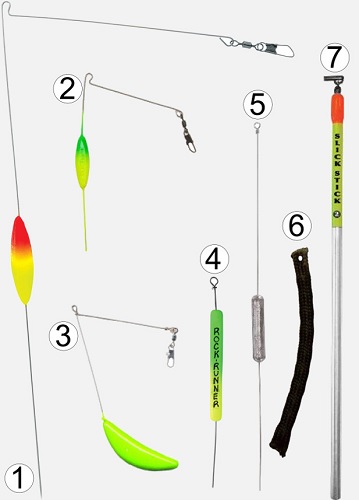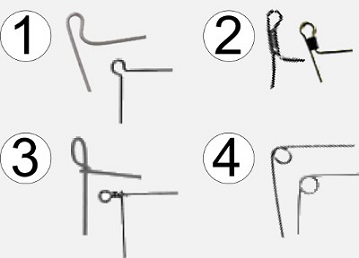A bottom bouncer is a simple piece of terminal tackle that is comprised of an inverted “L” shaped wire form with a weight and snap swivel attached. It’s typically used for drifting or trolling natural live bait, artificial plastics, spinners, spoons and crank baits in depths from 10 to 35+ feet. The set up is very simple. The main line is attached at the center of the bouncer, where the two “arms” meet, with a snap swivel; while the leader line, with the bait hook or lure, attaches to the the snap swivel on the bottom bouncer with a barrel swivel.

A monofilament or flourocarbon leader line is typically set at a length of 24″ to 72″. As the bottom bouncer is trolled it stays vertical and allows the bait or lure to be trolled just above the lake bottom while the bottom of the wire frame makes contact and ticks, or bounces, along the bottom creating some additional erratic action. To fish a bouncer rig you want to slowly let your line out as the boat is moving until you hit the bottom. If you don’t let it out slowly, you have a good chance of the rig getting tangled up. You’ll also want a reasonable stiff rod for bouncing. Bottom bouncer specific rods are available, but a good medium to medium-heavy rod should be just fine.
The overall design of the bottom bouncer is fairly standard. The bottom weighted arm is typically 10” to 12” tall while the shorter leader arm is ~4” to 6” long and are placed at an ~90 degree angle from each other(Figure 1-1). The elliptical weights come in various colors and in weights from 3/4 oz. to 4 oz.. What size you will use will depend on what water depth you’re targeting (Table 1).
There are also mini versions of bottom bouncers available as well that come in 1/4 oz. to 1.5 oz. weights (Figure 1-2) for fishing shallower and/or lighter baits; as well as a style that molds the weight at the bottom of the bouncer creating a stream-lined foot (Figure 1-3). Some even have removable weights so you can adjust the weight as needed. It’s important to understand the relationship between target depth,

boat speed, line diameter and bouncer weight. The faster the boat is moving, the larger the weight you will need to reach target depth. Using thinner diameter line, such as a superline, also eliminates drag and gets you down deeper. So, you may have to experiment with what works for you on any given day. Also, you don’t always want the bouncer hitting the lake bottom, such as when you are fishing a rocky section of a lake. In those instances, when you let out your line, once you hit bottom reel it up a bit until your far enough off the bottom to avoid snagging in the rocks or weeds.
Although slightly different in application, there are also the pencil style bottom bouncer weights. These are basically single arm bouncers comprised of only the weighted arm (Figure 1-4, and 1-5). These are actually slip-weights in that they are attached to the main line using a sliding clamp or quick change clevice. This allows the main line to slide through the weight and provides little resistance when a fish strikes. See the section on Slip-Weight Rigs for more information. It’s also worth mentioning a slightly different design of pencil weight that consists of a solid piece of stainless steel (Figure 1-6). I believe these are referred to as “chugging irons”, but the one depicted was recently brought to market by Northland Fishing Tackle. The supposed benefit of these solid steel weights is increased sensitivity, reduced water resistance and increased strength.
Most standard bottom bouncers follow the same design, but as with all fishing tackle, there are a couple of variations. A key one is the design of the site where your main line attaches between the two arms. There are at least four different designs – R-bend, crimped, twisted and looped (Figure 2). There are two main problems with these attachment sites. The biggest issue with the R-bend style is the bouncer is free to slide through your snap swivel. So, on occasion your main line swivel will end up at the end of the leader arm or near the weight. Not a huge problem since you just slide it back, but it can be annoying. I think this is why the other designs were implemented. Although more convenient, they offer a more serious problem. With these styles there is a risk your line will get wrapped up (especially with the looped design) which could lead to a cut line. Not something anyone wants to happen. So, I highly recommend the R-bend type of bottom bouncer.
Below I show various bottom bouncer rigs.

A) Bottom bouncer pulling a stick bait.

B) Bottom bouncer pulling a spoon.

C) Bottom bouncer pulling an in-line spinner.

D) Bottom bouncer pulling a crawler harness and nightcrawler.

E) Bottom bouncer pulling an Idaho spinner and a live minnow.

F) Bottom bouncer pulling a Junebug spinner and a live leech.

G) Bottom bouncer pulling a Victor spoon with a nightcrawler.

H) Bottom bouncer pulling a Macks Smile Blade worm harness with a nightcrawler.

I) Bottom bouncer pulling a spoon harness (blade replaced with a spoon, like a Little Cleo) with a nightcrawler.

J) Bottom bouncer pulling a wobble head harness with a nightcrawler.

K) Bottom bouncer pulling a Slow Death rig with half a nightcrawler.

L) Bottom bouncer pulling a Mack Smile Blade Slow Death rig with half a nightcrawler.
Bottom bouncers are very versatile and can be used to trolll almost any natural or artificial bait set up in depths from 10 to 50 feet. A great rig for trolling all open water seasons and works all fish species.
By Adam Dempsey, http://www.lineonfishing.com
